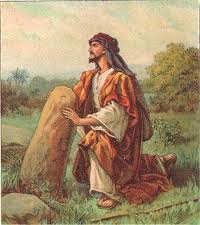by Rabbi Chanan Morrison ( based on the writings of Rabbi Kook zt”l)
the writings of Rabbi Kook zt”l)
After 20 years of hard labor under his treacherous uncle Laban, Jacob returned safely to the Land of Israel. Jacob succeeded in appeasing his brother Esau, and finally made it back to Bethel.
Bethel was the place where, as Jacob set out to leave the Land of Israel, he dreamt of a ladder reaching to the heavens, of angels, and Divine promises. Now Jacob fulfilled his 20-year-old promise, and erected a pillar (matzeiva) in God’s name.
It appears perfectly acceptable for Jacob to erect a pillar. Later on, however, the Torah specifically prohibits all pillars, even to worship God: “Do not erect a sacred pillar, which the Lord your God hates” (Deut. 16:22). What about Jacob’s pillar? The Sages explained that serving God through pillars “was beloved in the time of the patriarchs, but abhorred in the time of their descendants.”
Why did the status of pillars change?
To answer this question, we need to examine the difference between a pillar and a sanctuary. A pillar is a single large stone, focal point of Divine service, where all may gather around it. A sanctuary, on the other hand, is a house of worship, a building where the worshippers gather inside of it.
What is the significance of whether the worshippers gather around or inside?
The prophet Isaiah (2:3) predicted that, in the future, many nations will say, “Let us go up to God’s mountain, to the house of the God of Jacob.” Why will they be attracted to the God of Jacob, as opposed to the God of Abraham or the God of Isaac?
The Sages noted that the spiritual service of each of the Avot (patriarchs) was unique not only in its time-frame, but also in its spatial context:
•Abraham — served God in the mountain during the Akeida (the Binding of Isaac).
•Isaac — reached his own spiritual heights in the field where he meditated.
•Jacob — promised that the place of his lofty dream would become a house of God.
The Sages interpreted Isaiah’s prophecy as follows: The nations will desire — not the Mountain of Abraham, nor the Field of Isaac, but the House of Jacob (Pesachim 88).
What does this mean?
When Abraham began introducing the concept of one God into the world, he didn’t lecture on detailed, organized forms of worship. Abraham didn’t teach his followers 613 mitzvot that govern all aspects of life. Rather, he worked on spreading the overall concept of one Creator. The Mountain of Abraham and the Field of Isaac are a metaphor for this type of spiritual message, which, like an open field, was accessible to all.
This is also the service of the Pillar: a central point around which all may gather.
Jacob, on the other hand, promised to establish a house of worship. He envisioned the time when the Jewish people would be ready for a higher level of Divine service. The open, accessible service of Abraham would prepare the way for an all-encompassing, detailed service of Torah and mitzvot. The binding service of Jacob is represented by a House, with its enclosing walls surrounding the worshippers.
A second aspect of a house is that it differentiates between those who merit being inside, and those who do not. Once the Jewish people achieved this level of worship, and entered the elevated sanctuary, it was no longer appropriate for them to relate to God through the abstract service of pillars.
Isaiah prophesied that, in the future, the nations will recognize the greatness and power of a service of God that encompasses both the spiritual and physical realms. They will recognize the importance of good works, mitzvot and Halachic discipline. Then they will declare: Abstract theology and simple faith in God are not enough. Let us enter into the Sanctuary, into “the House of the God of Jacob.”
(adapted from Igrot HaRe’iyah vol. III, pp. 10-12 (letter 546))
Copyright © 2006 by Chanan Morrison
